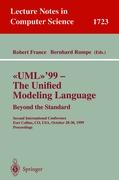UML'99 - The Unified Modeling Language: Beyond the Standard
BücherAngebote / Angebote:
\While in geometry attempts to square the circle never succeeded, the UML has achieved it: states canbeimplementedasclasses. "{\Wehavemade much progressfrom thetime cloudswere used. " The Uni ed Modeling Language is described as a language for \specifying, - sualizing, constructing, and documenting the artifacts of software systems" and for business modeling (OMG UML V1. x documents). The UML re?ects some of the best experiences in object-oriented modeling, thus it has the potential to become a widely-used standard object-oriented modeling language. As a generally-applicable standard the UML has to be both ?exible (ext- sible, adaptable, modia ble) and precise. Flexibility is needed if the UML is to be used in a variety of application domains. Tailoring of UML syntax and adaptation of UML semantics to system domains is highly desirable. Incor- rating domain-specic concepts into the language will yield modeling languages that more e ectively support system development in these domains. Tailoring may involve determining a subset of the UML that is applicable to the domain, extending or modifying existing language elements, or den ing new language elements. One can envisage UML variants that are tailored to specic domains, for example, UML for real-time systems, multimedia systems, and for intern- based systems. Furthermore, one can also de ne UML variants that determine levels of sophistication in the use of the UML.
Folgt in ca. 5 Arbeitstagen
